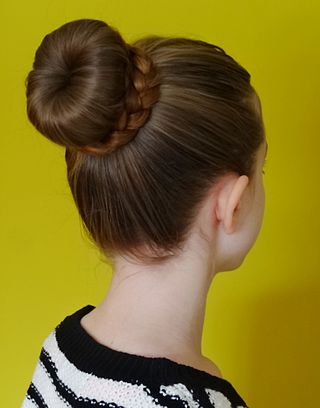Top Qs
Timeline
Chat
Perspective
Bun (hairstyle)
Type of hairstyle From Wikipedia, the free encyclopedia
Remove ads
A bun is a type of hairstyle in which the hair is pulled back from the face, twisted or plaited, and wrapped in a circular coil around itself, typically on top or back of the head or just above the neck. A bun can be secured with a hair tie, barrette, bobby pins, one or more hair sticks, or a hairnet. Hair may also be wrapped around a piece called a "rat".[1][2] Various hair bun inserts may be used to create donut-shaped buns.[3][4]
This article needs additional citations for verification. (April 2015) |

Remove ads
Double bun
Summarize
Perspective

Double or pigtail buns are often called odango (お団子),[5] which is also a type of Japanese dumpling (also called dango).
In China, it is common among young girls or women to have the two buns hairstyle, which is called yaji (丫髻) or shuangyaji (丫髻). The name comes from having hair buns, often two buns on either side of the crown of the head, giving the hair a shape similar to the Chinese character 丫.[6] This hairstyle was worn during many different Chinese dynasties. There are also other hair styles called niújiǎotóu (牛角头).[7] It was a commonly used hairstyle up until the early 20th century, and can still be seen today when traditional attire is used. This hairstyle differs from the odango in that it is gender neutral; Chinese paintings of children have frequently depicted girls as having matching ox horns, while boys have a single bun on the back.
In the United States they are called side buns, also known as "space buns", and were a popular festival hair trend in the 1990s.[8][9]
The 2015 film Star Wars: The Force Awakens had its protagonist, Rey, debut a "triple bun" hairstyle.[10]
Remove ads
In everyday culture
The position of a hair bun on the head can convey cues about the person's style, colored by social expectations. From the perspective of the United States, Hannah Goldfield wrote for The New York Times that a high bun "conveys a certain uncouth youthfulness, a sense of unseriousness, a need to provoke" and the low bun is its opposite. Perceptions have changed with time, however.[11]
Similarly, a messier bun, wherein hair is not pulled back tightly, can convey a carefree and casual persona or mood.[12]
Remove ads
Bun or top knot hairstyle in men
Summarize
Perspective
This section needs additional citations for verification. (August 2024) |


Men in ancient China wore their hair in a topknot bun (Touji 頭髻); visual depictions of this can be seen on the terracotta soldiers in the Terracotta Army sculptures. They were worn until the end of the Ming Dynasty in AD 1644, after which the Qing Dynasty government forced men to adopt the Manchu queue hairstyle (queue order).
Men of the Joseon Era of Korea wore the sangtu as a symbol of marriage. 16th century Japanese men wore the chonmage for samurai warriors and sumo wrestlers. In the west, topknots were frequently worn by "barbarian" peoples in the eyes of the Romans, such as the Goths, Vandals, and the Lombards. Later, the hairstyle survived in the pagan Scandinavian north (some believe the topknot hairstyle contains elements of Odinic cult worship) and with the eastern nomadic tribes such as the Bulgars, Cumans and Cossacks.
Rishi knot
The rishi (sage) knot is a topknot worn by Sikhi boys and men as a religious practice, in which the hair is formed into a bun. In the Sikh tradition, a turban is then worn atop the bun.[13][14] This hairstyle is also known as joora, and has been traditionally worn by Hindu mendicants.[15]
Man bun
The man-bun is a topknot influenced by the Asian style worn by long-haired men in the Western world. In London, the modern man-bun style may have begun around 2010, although David Beckham sported one earlier. The first Google Trends examples started to appear in 2013, and searches showed a steep increase through 2015.[16] Some of the first celebrities to wear the style were George Harrison, Jared Leto, Joakim Noah, Chris Hemsworth, Leonardo DiCaprio, Scot Pollard, and Orlando Bloom. The hairstyle is also associated with Brooklyn hipsters.[17]
See also
- List of hairstyles
- Bantu knot
- Chignon
- Guanli, the traditional Chinese coming of age ceremony, after which men ceased to trim their hair and wore it as a bun or topknot
References
External links
Wikiwand - on
Seamless Wikipedia browsing. On steroids.
Remove ads
